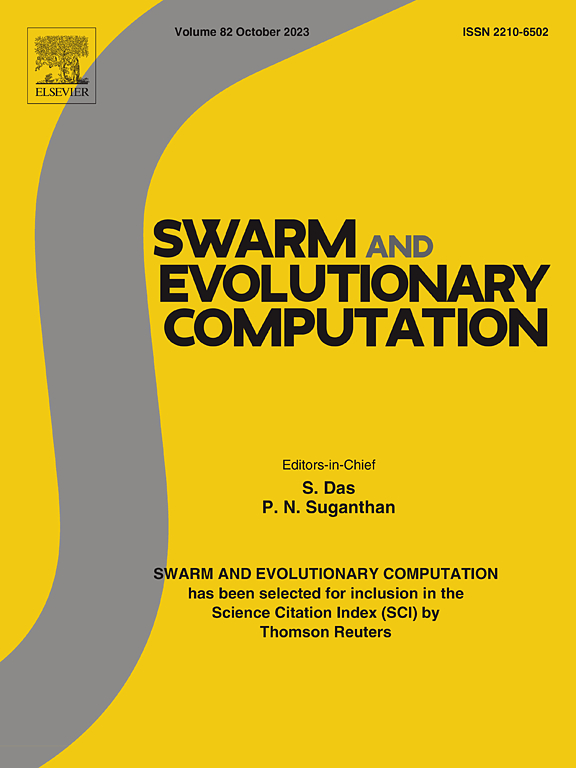A niching differential evolution with Hilbert curve for multimodal multi-objective optimization
IF 8.2
1区 计算机科学
Q1 COMPUTER SCIENCE, ARTIFICIAL INTELLIGENCE
引用次数: 0
Abstract
Multimodal multi-objective optimization problems have a many-to-one relationship between the decision space and the objective space. That is, distinct solutions in the decision space share the same objective value. How to coordinate population convergence and diversity while locating multimodal solutions is a challenging research topic. Some evolutionary algorithms using niching techniques have been reported in the literature. These algorithms prefer to induce multiple niches based on population information. Owing to the impact of convergence-first principle, the population tends to gather in easier-to-search regions, making it tough to yield more dispersed solutions in different niches. To remedy this situation, this paper proposes a niching differential evolution with Hilbert curve. First, a neighborhood-driven reproduction method is presented based on Hilbert curve, which features a two-layer architecture to capture promising regions and identify multimodal solutions. Second, a convergence-based density indicator is designed as a selection criterion to distinguish between convergence solutions and diversity solutions in the decision space. Moreover, fifteen intricate multimodal multi-objective test functions are devised. The experiments are performed on a series of test functions and a map-based practical problem. Empirical results attest that the proposed algorithm is competitive in dealing with multimodality compared with ten multimodal multi-objective algorithms.
多模态多目标优化的Hilbert曲线小生境差分进化
多模态多目标优化问题在决策空间和目标空间之间具有多对一的关系。也就是说,决策空间中的不同解共享相同的目标值。在寻找多模式解决方案的同时,如何协调人口的收敛性和多样性是一个具有挑战性的研究课题。一些使用小生境技术的进化算法已经在文献中报道过。这些算法倾向于基于种群信息诱导多个生态位。由于收敛优先原则的影响,人口倾向于聚集在更容易搜索的区域,这使得很难在不同的生态位中产生更分散的解决方案。为了纠正这种情况,本文提出了一个带有Hilbert曲线的小生境差分演化。首先,提出了一种基于Hilbert曲线的邻域驱动复制方法,该方法采用两层结构来捕获有希望的区域并识别多模态解。其次,设计了基于收敛性的密度指标作为选择准则,区分决策空间中的收敛性解和多样性解;设计了15个复杂的多模态多目标测试函数。在一系列测试函数和一个基于地图的实际问题上进行了实验。实验结果表明,与十种多模态多目标算法相比,该算法在处理多模态问题方面具有一定的竞争力。
本文章由计算机程序翻译,如有差异,请以英文原文为准。
求助全文
约1分钟内获得全文
求助全文
来源期刊

Swarm and Evolutionary Computation
COMPUTER SCIENCE, ARTIFICIAL INTELLIGENCEC-COMPUTER SCIENCE, THEORY & METHODS
CiteScore
16.00
自引率
12.00%
发文量
169
期刊介绍:
Swarm and Evolutionary Computation is a pioneering peer-reviewed journal focused on the latest research and advancements in nature-inspired intelligent computation using swarm and evolutionary algorithms. It covers theoretical, experimental, and practical aspects of these paradigms and their hybrids, promoting interdisciplinary research. The journal prioritizes the publication of high-quality, original articles that push the boundaries of evolutionary computation and swarm intelligence. Additionally, it welcomes survey papers on current topics and novel applications. Topics of interest include but are not limited to: Genetic Algorithms, and Genetic Programming, Evolution Strategies, and Evolutionary Programming, Differential Evolution, Artificial Immune Systems, Particle Swarms, Ant Colony, Bacterial Foraging, Artificial Bees, Fireflies Algorithm, Harmony Search, Artificial Life, Digital Organisms, Estimation of Distribution Algorithms, Stochastic Diffusion Search, Quantum Computing, Nano Computing, Membrane Computing, Human-centric Computing, Hybridization of Algorithms, Memetic Computing, Autonomic Computing, Self-organizing systems, Combinatorial, Discrete, Binary, Constrained, Multi-objective, Multi-modal, Dynamic, and Large-scale Optimization.
 求助内容:
求助内容: 应助结果提醒方式:
应助结果提醒方式:


